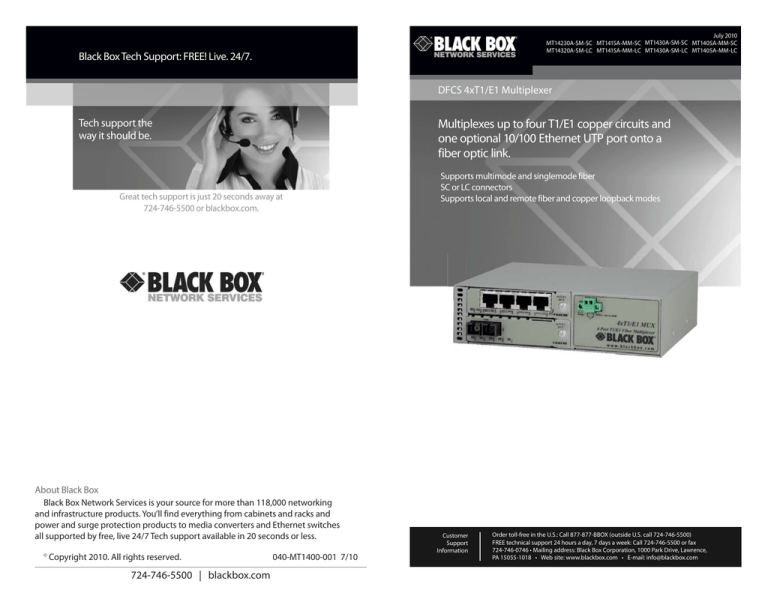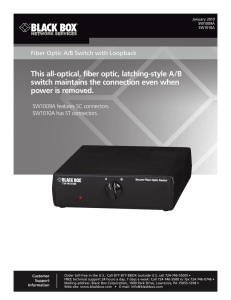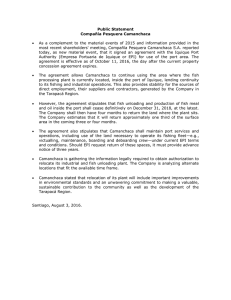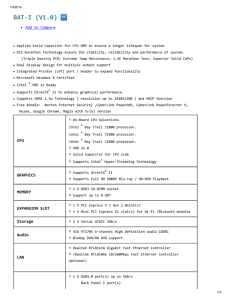Multiplexes up to four T1/E1 copper circuits and one optional 10/100
Anuncio

July 2010 MT14230A-SM-SC MT1415A-MM-SC MT1430A-SM-SC MT1405A-MM-SC MT14320A-SM-LC MT1415A-MM-LC MT1430A-SM-LC MT1405A-MM-LC Black Box Tech Support: FREE! Live. 24/7. DFCS 4xT1/E1 Multiplexer Tech support the way it should be. Multiplexes up to four T1/E1 copper circuits and one optional 10/100 Ethernet UTP port onto a fiber optic link. Great tech support is just 20 seconds away at 724-746-5500 or blackbox.com. Supports multimode and singlemode fiber SC or LC connectors Supports local and remote fiber and copper loopback modes About Black Box Black Box Network Services is your source for more than 118,000 networking and infrastructure products. You’ll find everything from cabinets and racks and power and surge protection products to media converters and Ethernet switches all supported by free, live 24/7 Tech support available in 20 seconds or less. © Copyright 2010. All rights reserved. 724-746-5500 | blackbox.com 040-MT1400-001 7/10 Customer Support Information Order toll-free in the U.S.: Call 877-877-BBOX (outside U.S. call 724-746-5500) FREE technical support 24 hours a day, 7 days a week: Call 724-746-5500 or fax 724-746-0746 • Mailing address: Black Box Corporation, 1000 Park Drive, Lawrence, PA 15055-1018 • Web site: www.blackbox.com • E-mail: [email protected] DFCS 4xT1/E1 Multiplexer Specifications Definitions of Terms FEDERAL COMMUNICATIONS COMMISSION AND INDUSTRY CANADA RADIO FREQUENCY INTERFERENCE STATEMENTS This equipment generates, uses, and can radiate radio-frequency energy, and if not installed and used properly, that is, in strict accordance with the manufacturer’s instructions, may cause interference to radio communication. It has been tested and found to comply with the limits for a Class A computing device in accordance with the specifications in Subpart B of Part 15 of FCC rules, which are designed to provide reasonable protection against such interference when the equipment is operated in a commercial environment. Operation of this equipment in a residential area is likely to cause interference, in which case the user at his own expense will be required to take whatever measures may be necessary to correct the interference. AIS Alarm Indication Signal (all 1’s) BERT Bit Error Rate Test LOF Loss of frame LOS Loss of Signal RAI Remote Alarm Indication RDI Reverse Defect Indication, same as RAI Changes or modifications not expressly approved by the party responsible for compliance could void the user’s authority to operate the equipment. This digital apparatus does not exceed the Class A limits for radio noise emission from digital apparatus set out in the Radio Interference Regulation of Industry Canada. Le présent appareil numérique n’émet pas de bruits radioélectriques dépassant les limites applicables aux appareils numériques de la classe A prescrites dans le Règlement sur le brouillage radioélectrique publié par Industrie Canada. Normas Oficiales Mexicanas (NOM) Electrical Safety Statement INSTRUCCIONES DE SEGURIDAD 1. Todas las instrucciones de seguridad y operación deberán ser leídas antes de que el aparato eléctrico sea operado. 2. Las instrucciones de seguridad y operación deberán ser guardadas para referencia futura. 3. Todas las advertencias en el aparato eléctrico y en sus instrucciones de operación deben ser respetadas. 4. Todas las instrucciones de operación y uso deben ser seguidas. 724-746-5500 | blackbox.com Page 2 Page 15 724-746-5500 | blackbox.com DFCS 4xT1/E1 Multiplexer NOM Statement Specifications Model Type Protocols (TDM) 4xT1/E1 MUX ANSI: T1.403, T1.102, AT&T: T62411, ITU: G.703, G.704, G.706, G.736, G.775, G.823, G.824, G.8261 ETSI: ETS 300 166 Protocols (Ethernet) 10BASE-T, 100BASE-TX, 100BASE-FX with 2044 bytes max. frame size Copper Connectors Ethernet: RJ-45 T1/E1: RJ-48 Fiber Connectors SFP: Dual Fiber: Controls LED Displays AC Power Input power requirements: 6. El aparato eléctrico debe ser usado únicamente con carritos o pedestales que sean recomendados por el fabricante. 7. El aparato eléctrico debe ser montado a la pared o al techo sólo como sea recomendado por el fabricante. 8. Servicio—El usuario no debe intentar dar servicio al equipo eléctrico más allá lo descrito en las instrucciones de operación. Todo otro servicio deberá ser referido a personal de servicio calificado. LC SC, ST, LC 9. El aparato eléctrico debe ser situado de tal manera que su posición no interfiera su uso. La colocación del aparato eléctrico sobre una cama, sofá, alfombra o superficie similar puede bloquea la ventilación, no se debe colocar en libreros o gabinetes que impidan el flujo de aire por los orificios de ventilación. UTP Crossover, CableType / Distance, Loop, Fiber AIS, UTP AIS, Fiber Optic Test 10. El equipo eléctrico deber ser situado fuera del alcance de fuentes de calor como radiadores, registros de calor, estufas u otros aparatos (incluyendo amplificadores) que producen calor. Power, Test, RJ-45/RJ-48 Link, Fiber Optic Link 100 to 240VAC 50/60Hz 0.5A @ 120VAC Connector: Dimensions 5. El aparato eléctrico no deberá ser usado cerca del agua—por ejemplo, cerca de la tina de baño, lavabo, sótano mojado o cerca de una alberca, etc.. 11. El aparato eléctrico deberá ser connectado a una fuente de poder sólo del tipo descrito en el instructivo de operación, o como se indique en el aparato. IEC320 W: 6.7” x D: 5.51” x H: 1.87” Weight 2.5 lbs Compliance 12. Precaución debe ser tomada de tal manera que la tierra fisica y la polarización del equipo no sea eliminada. UL, CE, FCC Class A Temperature Standard: 0 to 50º C Wide: -40 to 60º C Storage: -40 to 80º C Humidity 5 to 95% (non-condensing) Altitude -100m to 4000m 13. Los cables de la fuente de poder deben ser guiados de tal manera que no sean pisados ni pellizcados por objetos colocados sobre o contra ellos, poniendo particular atención a los contactos y receptáculos donde salen del aparato. 14. El equipo eléctrico debe ser limpiado únicamente de acuerdo a las recomendaciones del fabricante. MTBF (hrs) AC Model 150,000 Ethernet traffic on the optional Ethernet port has a maximum throughput of 80Mbps. 15. En caso de existir, una antena externa deberá ser localizada lejos de las lineas de energia. 16. El cable de corriente deberá ser desconectado del cuando el equipo no sea usado por un largo periodo de tiempo. 724-746-5500 | blackbox.com Page 14 Page 3 724-746-5500 | blackbox.com DFCS 4xT1/E1 Multiplexer LED Indicators Verify the Transport module is operational by viewing the LED indicators. 17. Cuidado debe ser tomado de tal manera que objectos liquidos no sean derramados sobre la cubierta u orificios de ventilación. LED Function “Legend” Color Off State ON / Blinking State Power “Pwr” Green No power Module has power A: El cable de poder o el contacto ha sido dañado; u Power “PS1”, “PS2”, “PS3” Green N/A N/A B: Objectos han caído o líquido ha sido derramado dentro del aparato; o Fiber Optic “FO” Green No fiber link ON: Fiber link is active 10 Hz Blinking: Data activity C: El aparato ha sido expuesto a la lluvia; o 10Mbps UTP “10” Green 10Mbps not selected or ON: Active 10Mbps UTP link disconnected 10 Hz Blinking: Data activity D: El aparato parece no operar normalmente o muestra un cambio en su desempeño; o 100Mbps UTP “100” Green 100Mbps not selected or ON: Active 100Mbps UTP link disconnected 10 Hz Blinking: Data activity UTP Full-Duplex “FDX” Green Half-duplex 18. Servicio por personal calificado deberá ser provisto cuando: E: El aparato ha sido tirado o su cubierta ha sido dañada. 724-746-5500 | blackbox.com Full-duplex Table 5: Transport Module LED Indicators Page 4 Page 13 724-746-5500 | blackbox.com DFCS 4xT1/E1 Multiplexer Trademarks Used in this Manual LED Indicator TRADEMARKS USED IN THIS MANUAL Function Black Box and the Double Diamond logo are registered trademarks of BB Technologies, Inc. Sys Stat Local Remote Off Off No power N/A Green - 1Hz Normal Not peered with remote Mux (searching) Green - 5Hz Normal Peering started with remote Mux, but not completed Green - ON Yellow - ON Green - ON Normal Peered with remote Mux Green - 1Hz Local fiber loopback Not peered with remote Mux (searching) Green - 5Hz Local fiber loopback Peering started, but not completed with remote Mux Green - ON Local fiber loopback Peered with remote Mux Green - 1Hz Remote fiber loopback initiated Not peered with remote Mux (searching); loopback failed Green - 5Hz Remote fiber loopback initiated Peering started, but not completed with remote Mux; loopback failed Green - ON Remote fiber loopback initiated Peered with remote Mux; loopback okay Yellow - ON Remote fiber loopback initiated Peered with remote Mux; loopback failed Green - ON Responding to remote fiber loopback Peered with remote Mux; loopback okay Yellow - ON Responding to remote fiber loopback Peered with remote Mux; loopback refused [possible if Copper Loopback is active] Green - 5Hz Circuit Test (BERT-test head) initiated Peering started, but not completed with remote Mux; circuit test failed Green - ON Circuit Test (BERT-test head) initiated Peered with remote Mux; circuit test okay Yellow - ON Circuit Test (BERT-test head) initiated Peered with remote Mux; circuit test failed Green Responding to Circuit Test (comparator) Peered with remote Mux; circuit test okay Yellow Responding to Circuit Test (comparator) Peered with remote Mux; circuit test failed Any other trademarks mentioned in this manual are acknowledged to be the property of the trademark owners. Yellow - 1Hz Yellow - 5Hz Alternating Green & Yellow - 1Hz Alternating Green & Yellow - 5Hz Table 4: “Sys” and “Stat” LED Indicators The same LED has the capability to be green or yellow depending on the condition as shown in the table above. When condition indicates both colors are blinking at the same time, this will appear as an alternating pattern. 724-746-5500 | blackbox.com Page 12 Page 5 724-746-5500 | blackbox.com DFCS 4xT1/E1 Multiplexer Operation Product Overview 4) Verify Operation The DFCS 4xT1/E1 MUX multiplexes up to four T1/E1 copper circuits and one optional 10/100 Ethernet UTP port onto a fiber optic link. The aggregated services can be extended up to 30km across a fiber pair. The 4xT1/E1 MUX must be used in pairs (bookends) across dark fiber. Verify the MUX is operational by viewing the LED indicators. LED Legend Color Pwr Power Sys Local System Status Green/Yellow Port 1 Local Link T1/E1 Status LED Green/Yellow P1 Lnk Figure 1: 4xT1/E1 Multiplexer with Optional Ethernet Port Function Green P1 Rmt Port 1 Remote Link Status LED Green/Yellow P2 Lnk Port 2 Local Link T1/E1 Status LED Green/Yellow P2 Rmt Port 2 Remote Link Status LED Green/Yellow P3 Lnk Port 3 Local Link T1/E1 Status LED Green/Yellow P3 Rmt Port 3 Remote Link Status LED Green/Yellow P4 Lnk Port 4 Local Link T1/E1 Status LED Green/Yellow P4 Rmt Port 4 Remote Link Status LED Green/Yellow Remote System Status Green/Yellow Stat Installation Procedure Table 2: 4xT1/E1 LED Indicators 1) Configure DIP-switches LED 2) Install MUX with AC Power Color/State OFF 3) Connect Cables 4) Verify Operation Lnk Function Loss of power or the Port Alarm Relay/LED switch is disabled Green - ON Local connected Green - 1Hz Local port LoS (RED Alarm) 1) Configure DIP-switches Yellow - ON Local port receiving AIS DIP-SWITCH BANK 1 Yellow - 1Hz Local port in T1/E1 copper loopback mode SW1 - SW4: Local Loopback Port 1 - Port 4 “Off / LBx” OFF These DIP-switches control the local loopback function for each T1/E1 port. When the DIP-switch is in the “LBx” position (where “x” is the T1/E1 port number), the corresponding port initiates a loopback per Figure 3. AIS (all 1s signal) from the local unit is transmitted across the fiber and out the corresponding T1/E1 port on the remote unit. When the DIPswitch is in the “OFF” (default), the port functions normally. Green - ON Remote T1/E1 port connected Green - 1Hz Remote T1/E1 port not connected or not synchronized Yellow - ON Remote T1/E1 port connected but receiving LoS, AIS or port in local loopback Rmt Lnk and Rmt (all ports) Loss of power or the Port Alarm Relay/LED switch is disabled Sequential Pattern (left to right) T1/E1 MUX Initializing Amber to Green Table 3: “Lnk” and “Rmt” LED Indicators Figure 2: DIP-switch Location 724-746-5500 | blackbox.com Page 6 Page 11 724-746-5500 | blackbox.com DFCS 4xT1/E1 Multiplexer Installation and Configuration 3) Connect Cables a. b. c. d. e. When using the SFP model, insert the SFP Fiber transceiver into the Port 1 SFP receptacle on the Transport module NOTE: The release latch of the SFP Fiber transceiver must be in the closed (up) position before insertion. Connect a Category 5 or better cable to the RJ-48 connectors on the DFCS T1/ E1 MUX, and attach the connectors at the other end of the UTP cable to the network equipment. When configured for E1 coax operation, use the optional adapter cables to convert the RJ-48 interface ports to dual BNC. When using a Transport module with the optional Ethernet port (see Figure 1 on page 3), connect the Ethernet 10/100 UTP port via a Category 5 or better cable to an external 10BASE-T or 100BASE-TX Ethernet device. Connect an appropriate multimode or single-mode fiber cable to the fiber port of the Transport module. It is important to ensure that the transmit (TX) is attached to the receive side of the device at the other end and the receive (RX) is attached to the transmit side. When using single-fiber (SF) models, the TX wavelength must match the RX wavelength at the other end and the RX wavelength must match the TX wavelength at the other end. Figure 3: Local Loopback SW5 - SW8: T1/E1 Line Configuration Settings These DIP-switches configure the MUX for T1/E1 operation and the copper line buildout. NOTE: Do not remove the modules from the chassis. Access to available DIP-switches can be found on the side of the chassis. SW5 SW6 SW7 SW8 Description Down Down Down Down T1 DSX-1: 0’ to 133’ (default) Down Down Down Up T1 DSX-1: 133’ to 266’ Down Down Up Down T1 DSX-1: 266’ to 399’ Down Down Up Up T1 DSX-1: 399’ to 533’ Down Up Down Down T1 DSX-1: 533’ to 655’ Down Down Down Down T1 DS1: 0dB Down Up Down Up T1 DS1: -7.5dB Down Up Up Down T1 DS1: -15dB Down Up Up Up Up Down Down Down E1 75 Ω Coax/BNC Standard Up Down Down Up E1 120 Ω RJ-45/48 Standard Up Down Up Down E1 75 Ω Coax/BNC Extended Up Down Up Up E1 120 Ω RJ-45/48 Extended T1 DS1: -22.5dB Table 1: T1/E1 Line Build-Out DIP-SWITCH BANK 2 SW1 - SW4: Port Alarm Relay/LED P1-P4 Alarms “Act / Off” These DIP-switches enable/disable the port alarm relay and LED function for the corresponding port. When this DIP-switch is in the “Act” down position (default), the alarm relay and “Lnk” and “Rmt” LEDs are enabled. When the DIP-switch is in the “Off” up position, the alarm relay and “Lnk” and “Rmt” LEDs are disabled. The Port Alarm Relay is a two pin terminal connector located on the front panel of the 4xT1/E1 Multiplexer. It will close when any of the following port alarm conditions are detected (i.e. alarm relay port 1 will activate when an alarm condition is detected on port 1). • • • • 724-746-5500 | blackbox.com Page 10 Power loss The detection of AIS or Loss of Signal (LoS) on the T1/E1 copper port The detection of AIS or LoS on any remote T1/E1 copper port When the T1/E1 MUX is not peered with its remote partner Page 7 724-746-5500 | blackbox.com DFCS 4xT1/E1 Multiplexer Installation SW5: Circuit Test (C/T) Mode “Off / On” When this DIP-switch is in the “Off” down position (default), the Circuit Test Mode is disabled. When this DIP-switch is in the “On” up position, the Circuit Test Mode is enabled. When Circuit Test mode is enabled, both MUXes will transmit a known test pattern. The test pattern is received by the other unit and checked for errors. AIS is transmitted out all T1/E1 ports and incoming T1/E1 traffic is discarded. See Figure 4 for Circuit Test Mode diagram. Figure 6: Remote Fiber Loopback SW8: T1/E1 Line Codes - B8ZS/HDB3 or AMI When this DIP-switch is in the “B8ZS/HDB3” down position (default), the MUX is configured for B8ZS (T1) or HDB3 (E1) line coding. When the DIP-switch is in the “AMI” up position, the MUX is configured for AMI line coding. 2) Install MUX with AC Power a) AC Powered Chassis Site Preparation Power source should be available within 5 ft. of the chassis and installed per the National Electrical Code ANSI/NFPA-70. This equipment requires a 100-240VAC, 0.5Amp, 50/60Hz power outlet. Appropriate overloading protection should be provided on the AC power source outlets utilized. Figure 4: Circuit Test Mode The standard operating temperature of this equipment is 0 to 50 degrees C. If installed in a closed or multi-module rack assembly, the operating ambient temperature of the rack must not exceed the maximum rated 50 degrees C. See specifications on page 13 for wide temperature ranges. SW6: Local Fiber Loopback “Off / Loc” When this DIP-switch is in the “Off” down position (default), local fiber loopback is disabled. When this DIP-switch is in the “Loc” up position, local fiber loopback is enabled on the MUX. AIS is transmitted across the fiber and out all remote T1/E1 ports. Incoming T1/E1 traffic at the remote unit is discarded. See Figure 5 for local fiber loopback diagram. Installation of the equipment should be such that the air flow in the front, back and side vents of the chassis are not compromised or restricted. Never use this equipment to carry any weight except its own. Never use it as a shelf to support the weight of other equipment. b) AC Powered Chassis Mounting Attach the AC power cord to the back of the Power Receptacle and plug into the AC outlet. Any installed DFCS modules will illuminate the power LED. Figure 5: Local Fiber Loopback SW7: Remote Fiber Loopback - “Off / Rmt” When this DIP-switch is in the “Off” down position (default), remote fiber loopback is disabled. When this DIP-switch is in the “Rmt” up position, remote fiber loopback is enabled on the MUX. In this mode, the local unit forces the remote MUX into loopback. AIS is transmitted out all remote T1/E1 ports. Incoming T1/E1 traffic at the remote unit is discarded. See Figure 6 for remote fiber loopback diagram. 724-746-5500 | blackbox.com Page 8 Figure 7: Rear View with Power Cord Page 9 724-746-5500 | blackbox.com



